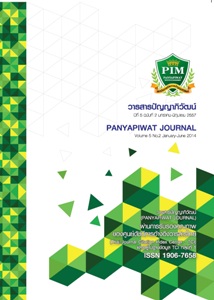ธุรกิจอัจฉริยะกับความท้าทายในการพัฒนาเพื่อใช้ในองค์กร
Main Article Content
บทคัดย่อ
บทคัดย่อ
ธุรกิจอัจฉริยะเป็นการรวมข้อมูลการดำเนินงาน (Operational data) โดยมีเครื่องมือต่าง ๆ ในการวิเคราะห์ข้อมูลและพร้อมที่จะนำเสนอข้อมูลที่ซับซ้อนเหล่านี้และให้เหมาะกับการแข่งขันและการวางแผนตัดสินใจ ธุรกิจอัจฉริยะมีจุดประสงค์เพื่อพัฒนาคุณภาพของข้อมูลที่นำเข้าสู่กระบวนการตัดสินใจ ธุรกิจอัจฉริยะถูกใช้เพื่อความเข้าใจกับความสามารถที่มีอยู่ในองค์กรโดยแสดงผ่านข้อมูลที่ดำเนินการอยู่ขององค์กร รวมถึงแสดงแนวโน้มและทำนายผลของแนวโน้มที่อาจเกิดขึ้นกับองค์กร บทความนี้นำเสนอแนวคิดการใช้ธุรกิจอัจฉริยะเพื่อพัฒนาองค์กรในด้านต่าง ๆ และอธิบายถึงการทำงานขององค์ประกอบหลักของสถาปัตยกรรมของธุรกิจอัจฉริยะ อีกทั้งนำเสนอแนวทางความท้าทายหลายด้านที่มีผลกระทบในการสร้างธุรกิจอัจฉริยะในองค์กร ซึ่งความท้าทายเหล่านี้มีผลกับการวางแผนและมีผลถึงความสำเร็จขององค์กร แนวโน้มเทคโนโลยีต่าง ๆ เช่น Big Data, Cloud computing ที่มีการพัฒนาร่วมกับธุรกิจอัจฉริยะในอนาคต
Abstract
Business Intelligence (BI) combines operational data with analytical tools to present complex and competitive information to planners and decision makers. The objective is to improve the quality of inputs to the decision process. Business Intelligence is used to understand the capabilities available in the firm; the state of the art, trends, and future directions of the markets. This paper proposes a BI framework and potential research topics. The framework emphasizes to the importance of the main functional components of the architecture of the BI system. In addition, this paper explores the challenge of BI development in the firm. These challenges are effect on the effective planning and the success of the organization. The future technologies, such as Big Data, Cloud computing that would be involved in BI system.
Article Details
“ข้าพเจ้าและผู้เขียนร่วม (ถ้ามี) ขอรับรองว่า บทความที่เสนอมานี้ยังไม่เคยได้รับการตีพิมพ์และไม่ได้อยู่ระหว่างกระบวนการพิจารณาลงตีพิมพ์ในวารสารหรือแหล่งเผยแพร่อื่นใด ข้าพเจ้าและผู้เขียนร่วมยอมรับหลักเกณฑ์การพิจารณาต้นฉบับ ทั้งยินยอมให้กองบรรณาธิการมีสิทธิ์พิจารณาและตรวจแก้ต้นฉบับได้ตามที่เห็นสมควร พร้อมนี้ขอมอบลิขสิทธิ์บทความที่ได้รับการตีพิมพ์ให้แก่สถาบันการจัดการปัญญาภิวัฒน์หากมีการฟ้องร้องเรื่องการละเมิดลิขสิทธิ์เกี่ยวกับภาพ กราฟ ข้อความส่วนใดส่วนหนึ่งและ/หรือข้อคิดเห็นที่ปรากฏในบทความข้าพเจ้าและผู้เขียนร่วมยินยอมรับผิดชอบแต่เพียงฝ่ายเดียว”
เอกสารอ้างอิง
Azvine, B., Cui, Z., Nauck, D. D. & Majeed, B. (2006). Real Time Business Intelligence for the Adaptive Enterprise. Proceedings of the 8th IEEE International Conference on E-Commerce Technology and the 3rd IEEE International Conference on Enterprise Computing, E-Commerce and E-Services (CEC/EEE?06), pp. 29.
Al-Aqrabi, H., Liu, L., Hill, R. & Antonopoulos, N. (2012). Taking the Business Intelligence to the Clouds. Proceedings of the 14"" IEEE International Conference on High Performance Computing and Communications, Liverpool, pp. 953-958.
Bento, A. & Bento, A. (2011). Cloud Computing: A new phase in IT Management. Journal of Information Technology Management, 22 (1), pp. 39-46.
Chen, H., Chiang, R. H. L. & Storey, V. C. (2012). Business Intelligence and Analytics: from Big Data to Big Impact. MIS Quarterly, Vol. 36, No. 4
Cui, Z., Damiani, E., & Leida, M. (2007). Benefits of Ontologies in Real Time Data Access. Digital Ecosystems and Technologies Conference, DEST.
Han, J., Kamber, M., & Pei, J. (2011). Data Mining: Concepts and Techniques, 3rd edition, Morgan Kaufmann.
Keen P. G. W. (1978). Decision support systems: an organizational perspective. Reading, Mass., Addison-Wesley Pub. Co.
Glaser, J. & Stone, J. (2008). Effective use of Business Intelligence, Healthcare Financial Management,62(2): pp. 68-71. ABI/INFORM Global.
Martin, A., Lakshmi, T. M. & Venkatesan, V. P. (2012). An Analysis on Business Intelligence Models to Improve Business Performance. Proceedings of the IEEE International Conference on Advances in Engineering, Science and Management (ICAESM-2012), Tamil Nadu, pp. 503-508.
Moody, D. L. & Kortink, M. A. R. (2000). From Enterprise Models to Dimensional Models: a Methodology for Data Warehouse and Data Mart Design. Proceedings of the 2nd International Workshop on Design and Management of Data Warehouses, pp. 1-12.
Nemati, H. R. & Barko, C. D. (2001). Issues in organizational data mining: a survey of current practices. Journal of Data Warehousing, Vol. 6 No.1, Winter, pp.25-36.
Rahmad, N., Aldhaban, F. & Akhter, S. (2013). Emerging Technologies in Business Intelligence. Proceedings of the IEEE International Conference on Technology Management in the IT-Driven Services (PICMET'13), San Jose, CA, pp. 542-547.
Raymond, R. C. (1966). Use of the Time-sharing Computer in Business Planning and Budgeting. Management Science, 12, 8, pp. 363-381.
Rizvi, H. (2013). Fast Data Gets a Jump on Big Data. Forbes, March 1.
Russom, P. (2013). Introduction to High-Performance Data Warehousing. What Works in Data Management, Vol. 35.
Shi, Y. & Lu, X. (2010). The Role of Business Intelligence in Business Performance Management. Proceedings of the 3" IEEE International Conference on Information Management, Innovation Management and Industrial Engineering, Kunming, pp.184-186.
Stackowiak, R., Rayman, J. & Greenwald, R. (2007). Oracle Data Warehousing and Business Intelligence Solutions, Indianapolis : Wiley Publishing, Inc.
Turban, E. (1967). The Use of Mathematical Models in Plant Maintenance Decision Making. Management Science, 13, 6, pp. 342-359.
Turban, E., Sharda, R., Delen, D. & King, D. (2007). Business Intelligence, 2nd edition, New Jersey :Prentice Hall.
Urban, G. L. (1967). SPRINTER: A Tool for New Products Decision Makers. Industrial Management Review, 8, 2, p. 43-54.
Vera-Baquero, A., Colomo-Palacios, R. & Molloy, O. (2013). IT Professional, Vol.15, Issue 6, pp. 29-35.
Wang, F. Y., Yan, A. M., Li, X. Z., & Yang, L. F. (2011). Cloud Computing Based Business Intelligence Platform and its Application in the field of Intelligent Power Consumption. Proceedings of the IEEE international Conference on Electronics, Communications and Control (ICECC), Ningbo, pp. 3612-3616.
Zeng, L., Xu, L., Shi, Z., & Wang, M. (2006). Techniques, Process, and Enterprise Solutions of Business Intelligence. Proceedings of the IEEE International Conference on Systems, Man and Cybernetics, Taipei, pp. 4722-4726.


